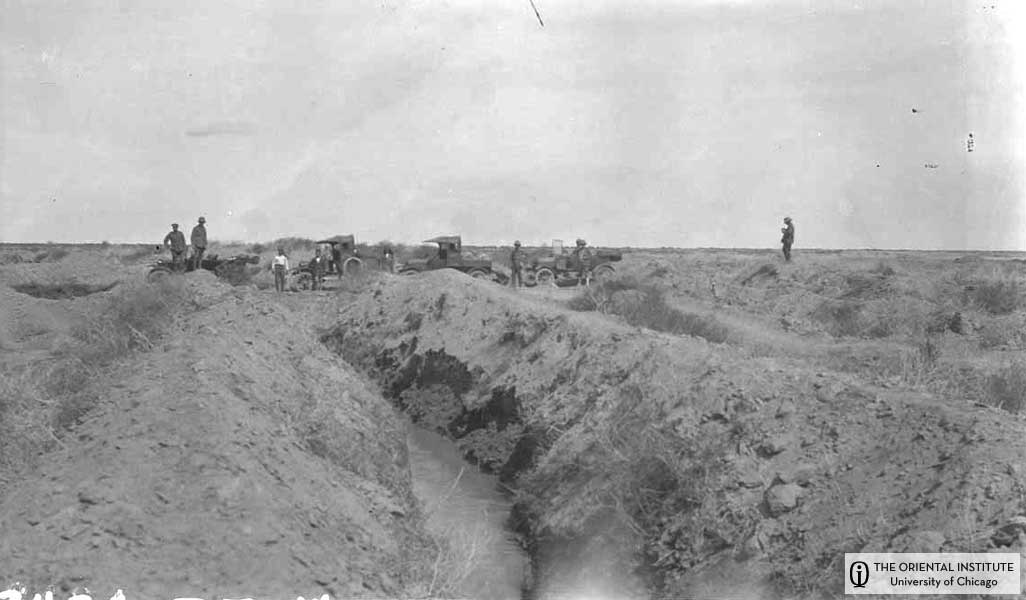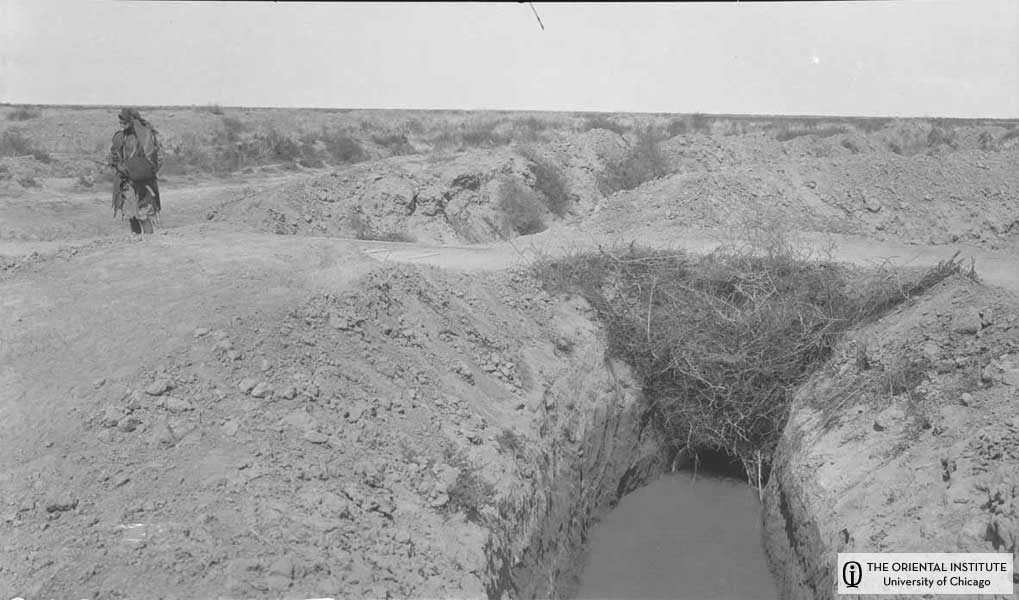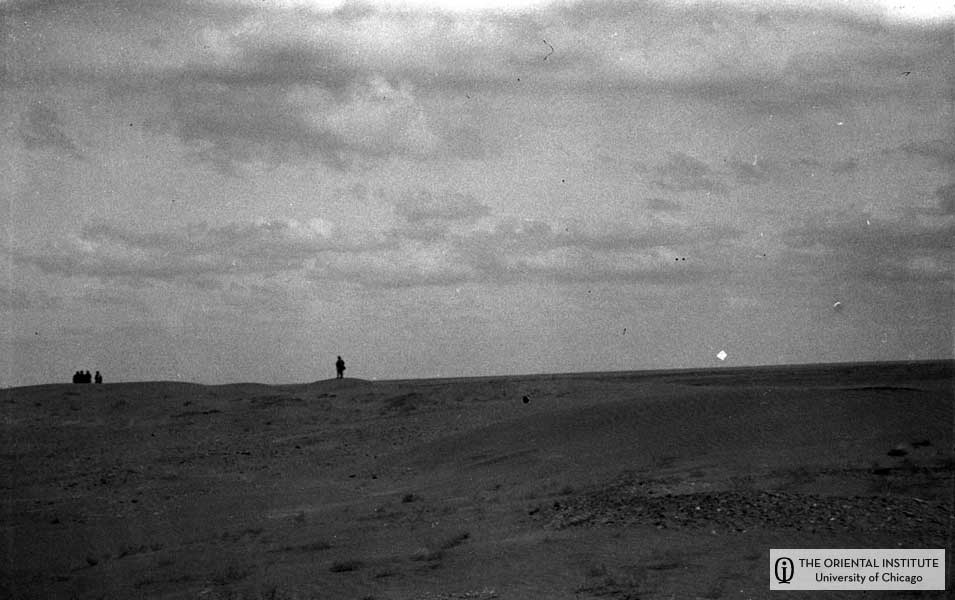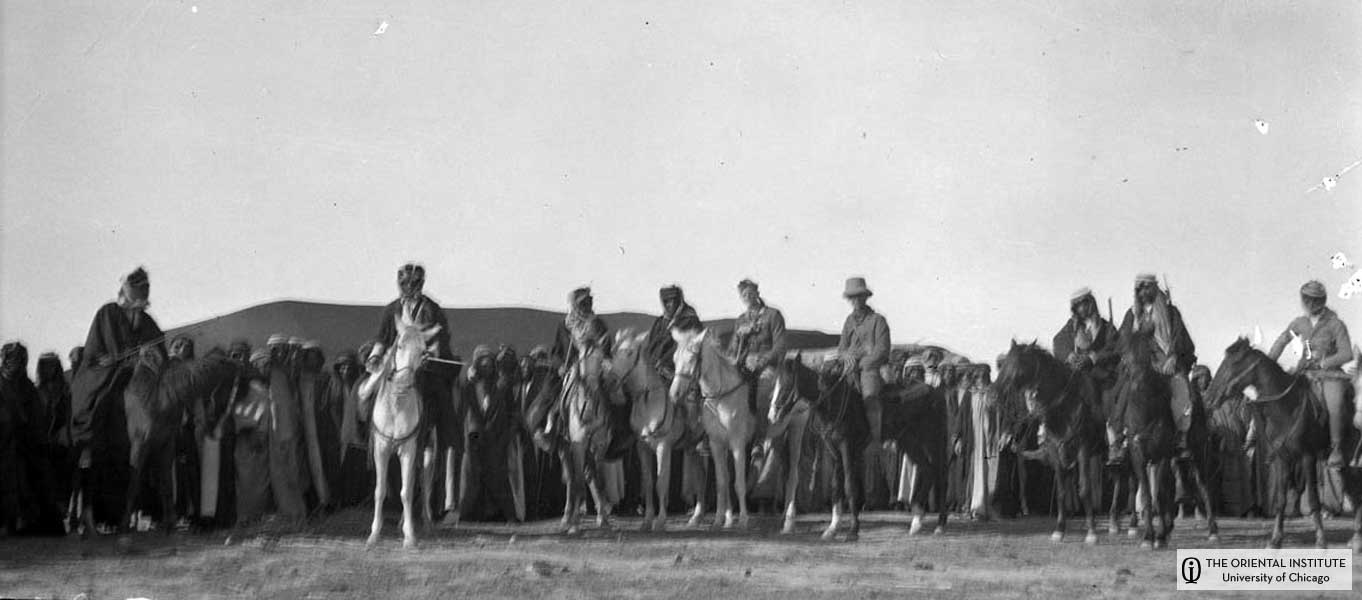Launch "Ballia", Shatt el-Hai
March 24, 1920
Below Kal’at es-Sikkar, Mesopotamia,
We have ascended the Shatt el-Hai to a point about halfway between the Tigris and Euphrates, and are now returning to the Euphrates for its ascent. The two days at Kal’at es-Sikkar were eventful. I wish I could tell you of our accommodations and the wretched hovel in which Captain Crawford lives, and which was all he had to offer us, but I must use this trip on the shaky launch to tell you of our adventures at Kal’at es-Sikkar. We spent Sunday afternoon, what was left of it,—resting and discussing our plans with Crawford.
Immediately after breakfast Monday morning Captain Crawford had horses ready for us, and we rode off with a guide and sowâres or mounted Arab guards with rifles. We rode northeast from Kal’at es-Sikkar out of the picturesque gate of the little town, where the women were coming in with heavy water skins on their backs or jars on their heads. We had not gone far when my horse bolted. Edgerton, who had never ridden at all before our Tello trip, was riding next me, and his horse at once followed mine. The Arabs usually put only halters on their horses, much as they do with camels. We therefore pulled on the rope reins in vain, the pressure coming on the animal’s neck and not on his mouth. The desert was as flat as a floor, but the irrigation trenches with hard baked embankments on each side confronted us every 100 yards. The horses took them in one flying leap after another. I thanked the Lord I had ridden as a boy and shouted to Edgerton to hug his horse with his legs. At length the willful brutes were caught in the angle between two trenches coming together at right angles. They were deep and unfortunately dry. Edgerton’s horse did wonderfully and to my surprise went over just in front of me in splendid style. The first trench left my horse too low, — he failed to rise over the next embankment and came down all standing while I went on. I never lost hold of the halter rope, and the horse trying to bolt of course as soon as he got his feet again, found himself halted. There he stood with the saddle under his belly gazing quietly at me, and I at him. I did not get a scratch, — nor so much as break my glasses, though they were so splattered I could only see out in spots. I could see Edgerton a mile away, rapidly disappearing on the horizon. Then I noticed some Bedwin tents close by, and a dark Bedwi running out to help, and praising Allah that I was all right. The rest of the party were far out of sight below the horizon. One of our Arab guards at length rose over the sky line galloping after me, and it was only as I saw him far off on the vast Babylonian plain that I realized I was alone in the heart of the Arab wilderness. It was a curious sensation, and made me fully realize the abrupt transition from a scholar’s study in University Avenue and the amenities of university life to the nomad wilderness of Western Asia and its many survivals from the prehistoric barbarism of the Orient. I would not have missed the experience for a king’s ransom!
 Shatra: Canals along the Shatra road. Oriental Institute party in the background. March 24, 1920. (N. 3484, P. 7044)
Shatra: Canals along the Shatra road. Oriental Institute party in the background. March 24, 1920. (N. 3484, P. 7044)
 Shatra: Thorn bridge over canal along the Shatra road. March 24, 1920. (N. 3485, P. 7045)
Shatra: Thorn bridge over canal along the Shatra road. March 24, 1920. (N. 3485, P. 7045)
The Arabs righted my outfit, but asked me to take another horse! I said by no means, but they must put on a bridle. They brought one from the tents and put it on the horse, and when I mounted he danced and bucked like a young mustang. The Arab bit is a barbarously cruel contrivance, and it was half an hour before the poor brute settled down to accept his distress philosophically. We finally overtook Edgerton among some Bedwin tents, and I was greatly relieved to find him uninjured. Before we got him settled on a quiet horse, his nag bolted again in spite of a bridle, and the boy fell off intentionally just before reaching a deep trench where he would surely have come to grief.
We were at length off again and a ride of 2-1/2 hours brought us to the extensive mounds of Tell Amûd, an unknown ancient city. It had rained dismally all the way out. The surface of the mound was a sea of sticky mud and we waded about with a great mass of it on each foot, while the steady downpour made it difficult to keep our records. As we devoured our lunch, we sat in the downpour on a few ancient bricks. The mounds are covered with broken pot-sherds, many of them fine green glazed fragments of Persian vases. The place had evidently not been inhabited since Neo-Persian times. I finally found the fragments of a large and handsome two-handled Persian vase of green glaze with chain pattern decoration which when put together made up practically a complete specimen worth 100 pounds at least. But we could not carry the fragments home on horseback and they still lie on the mound. We searched in vain for an inscription, — especially a stamped brick which might have contained a dedication revealing the name of the place. We wandered far and wide through the drizzle over an extensive circuit of mounds, but found no inscription. It was a strange and rather tantalizing experience to look out over this once populous city, endeavoring to repeople its vanished houses with the life that once flourished here, and has now passed away, leaving not even a name that might give it identity. Excavation would without doubt disclose it. As we rode away the rain ceased.
The next day (Tuesday, March 23) Captain Crawford had horses assembled on the other side of the river (west side) and we rode off southwest for Tell Yokha. It was a long and wearisome ride of nearly five hours, but interesting and instructive every step of the way. Five of the neighboring sheikhs had signified their desire of riding out with us, and Crawford too was with us. We had 5 Arab guards armed with rifles, and together our cavalcade numbered 16 horsemen. At our first group of over a hundred dark camel’s hair tents, there was a strong mud fort with tall round towers, intended as a place of refuge for the tribes when one of the incessant tribal wars was on. The sheikh came out to greet us, accompanied by a servant bearing coffee,—the never failing symbol of hospitality. As we rode on, two more sheikhs from a somewhat turbulent tribe which had been recently bombed by British airmen, came in and assumed a friendly attitude.
All around us on the plain were the distant mounds of ancient cities, — all of them unknown. One of the Arabs who could read gave me their names, and I have recorded them all (six in number) with the correct Arabic spelling. We rode up on the mounds of one of them, Tell Libadîyeh, but there was nothing on the surface to reveal its identity. About 1:30 having been in the saddle nearly 5 hours, and having come 23 miles from Kal’at es-Sikkar, we rode up among the vast mounds of Tell Yokha. Luckenbill is so heavy he had been having constant trouble with his horse, and although he had changed several times, he and Edgerton were miles in the rear accompanied by two of the Arab guards, for I had galloped on far in advance in order to inspect Tell Libadîyeh which lay somewhat off our line of march, and Captain Crawford had followed.
So we were far in advance as we ascended the mounds of Yokha. To my surprise we found things encumbered with great drifts and dunes of sand, which had drifted in from a stretch of desert 4 hours to the north, showing very vividly what I had long known, that there is sand desert even between the Two Rivers.
 Tel Yôlcha: Drifting sand covering Tel Yôlcha. The man standing alone is probably Luckenbill; the four standing together are probably Breasted, Crawford, and two Arabs. March 23, 1920. (N. 44635, P. 65861)
Tel Yôlcha: Drifting sand covering Tel Yôlcha. The man standing alone is probably Luckenbill; the four standing together are probably Breasted, Crawford, and two Arabs. March 23, 1920. (N. 44635, P. 65861)
The mounds of Yokha are of vast extent. The strong north wind was driving the sand into our eyes, and besides this, it was too late to make our usual sketch plan of the extent of the ruins. Shelton had managed to hang pretty close to our flanks, and he soon came over to us. A moment later he plucked my sleeve and said, “Who are all these”? Looking where he pointed, I saw a body of 30 or 40 Arab horsemen, sweeping up the slope of the mound directly upon us. Crawford was 50 paces away and did not see them. I walked over to him and asked him to look round. His face never changed, and with the utmost composure he asked our Arabs who these horsemen were. They replied they were the Bnê Ghweinîn. In a moment they halted, drawn up in an impressive line, like a platoon of cavalry on parade. The Bnê Ghweinîn had been recently bombed by British airmen; their sheikh and many of his followers had been outlawed, and these were the men before us, a hundred paces away. Crawford was splendid. He folded his arms and quietly contemplated the horsemen. We had 5 rifles and they had 30 or 40. We were completely at their mercy far out in the Arab wilderness. Crawford said afterward, “I thought we were surely done in”. He is 26, — but he has a wound in one leg not yet entirely healed, part of his right hand shot away, and a bullet through his stomach. Needless to say a volley from the outlaws would not have disturbed him! Four sheikhs dismounted from their horses, left them in the line and came forward to us. The sheikhs in our party introduced them and they all stepped forward and kissed Crawford’s right shoulder, at the same time dropping from their heads their rope-like agâlas arranged in coils over their headcloths. To let the agâla fall thus to the shoulders is a token of complete submission. It was quite evident that this had all been arranged beforehand by the sheikhs who accompanied us. Crawford told Sheik Miz’al he must come along with him to Kal’at es-Sikkar and afterward to headquarters at Nasiriya to make his formal submission there and stand his trial for his misdeeds. Miz’al was not expecting this and the palaver which followed was long and interesting as one sheik after another took up the word. Miz’al did not assent but rode with us nevertheless to the tents of his tribe,—a two hour’s ride eastward toward the river, the Arabs shouting, racing at wild speed, caracoling their horses in wide curves and brandishing their rifles.
 Tell Yokha: The outlaw Sheikh Miz’al and his fellow-outlaws of the Albu-Ghwenîn after formal submission to Captain Crawford, assistant political officer at Kal’at es-Sikkar. Mizil, deposed sheikh of Kalat es-Sikkar, submitting to Captain Crawford. March 23, 1920. (N. 3190, P. 6750)
Tell Yokha: The outlaw Sheikh Miz’al and his fellow-outlaws of the Albu-Ghwenîn after formal submission to Captain Crawford, assistant political officer at Kal’at es-Sikkar. Mizil, deposed sheikh of Kalat es-Sikkar, submitting to Captain Crawford. March 23, 1920. (N. 3190, P. 6750)
 Tell Yokha: Part of our Arab escort in Lower Babylonia; seven sheikhs accompanied the expedition on a forty-mile ride from Kal’at es-Sikkar on the Shatt el-Hai to Tell Yokha, ancient Umma. Arab sheikhs of Kalat es-Sikkar with Captain Crawford. March 23, 1920. (N. 3191, P. 6751)
Tell Yokha: Part of our Arab escort in Lower Babylonia; seven sheikhs accompanied the expedition on a forty-mile ride from Kal’at es-Sikkar on the Shatt el-Hai to Tell Yokha, ancient Umma. Arab sheikhs of Kalat es-Sikkar with Captain Crawford. March 23, 1920. (N. 3191, P. 6751)
 Tell Yokha: A view looking over the northeast end of the mound. Captain Crawford and Arabs at the left. The mound is partly covered with dried sand. March 23, 1920. (N. 3513, P. 7073)
Tell Yokha: A view looking over the northeast end of the mound. Captain Crawford and Arabs at the left. The mound is partly covered with dried sand. March 23, 1920. (N. 3513, P. 7073)
Here we arrived about 4:30 p.m. and were at once taken to the madhîf or guest-tent of Sheik Mutlaq, Miz’al’s brother, who is now sheikh in Miz’al’s stead. The big black camel’s hair tent, open on one side, was carpeted with gay rugs and at the right were cushions where Crawford and I seated ourselves, the rest of our party on our right, then the sheikhs who were with us, and the notable men of the tribe. Tea and cigarettes were at once brought in and passed by Sheik Mutlaq himself. Then four men appeared carrying between them an enormous tray heaped high with boiled rice on which lay two whole roast sheep. It was set down in the midst and a smaller tray of rice, together with numerous roast chickens, pieces of roast mutton, bowls of clabbered milk, and generous piles of Arab bread, were all placed before our party. As we fell to, the leading sheikhs gathered around the big tray, and a circle of dark hands carried the food to a circle of dark faces in a scene which I am really too tired to describe. The food was really well cooked and delicious, but imagine drinking clabbered milk from a bowl the outside of which, under the rim, was reeking with filth, left there by many Arab mouths. I thought of our paper cups in public drinking places, and being hungry and thirsty (for we had had nothing to eat since early morning) I shut my eyes and drank. Circle succeeded circle around the big tray and then it was carried out for the women and children. Only the skeletons of two sheep still surmounted the remnants of the rice.
 Tell Yokha: Reception of Mitlak, successor to Mizil (Messrs. Shelton and Bull in the foreground). March 23, 1920. (N. 3515, P. 7075)
Tell Yokha: Reception of Mitlak, successor to Mizil (Messrs. Shelton and Bull in the foreground). March 23, 1920. (N. 3515, P. 7075)
There was now a stir in the assembly and suddenly, where the big tray had just stood, appeared two holy men (sayyids) accompanied by Sheikh Miz’al. All three knelt before Crawford, and Miz’al at once prostrated himself with his forehead to the ground, and with words of contrition, begged forgiveness, while the two holy men also interceded on his behalf. An Arab is a very proud man, and it was an extraordinary sight to see a Sheikh thus humiliate himself before his whole tribe. Along the open side of the tent the tribesmen pressed anxiously forward an array of expectant faces which quite surpassed description in the divergent features of the highly varied and picturesque types. Other Sheikhs also pleaded for Miz’al, but Crawford was quite unyielding. The sheik must ride with him to Kal’at es-Sikkar, and afterwards stand trial at Nasiriyeh. The scene went on thus for half an hour. This imperturbable young Englishman sitting here unarmed in the midst of a wild Arab tribe, who outnumbered us 50 to one, and could have slaughtered us all in a few minutes, swayed them like a king. As he concluded the interview by rising, and going out to his horse, the whole tribe surged about us, and all at once they opened a passage and five women passed rapidly up to us. They were Miz’al’s four wives and his mother, coming out to plead for him. I mounted my horse and rode out of the press to snap a photograph of the extraordinary scene. As I rode away I found Miz’al’s mother and one of the wives at my elbow wailing out appeals for the outlaw. We all rode off rapidly, Crawford looking back at intervals to see if Miz’al was following. His people were evidently advising him not to go and we saw no more of him.
Another two hour’s ride, the last half hour in darkness, making the network of canals, trenches and steep embankments difficult to negotiate, brought us to the river, where after some delay we found Crawford’s launch. We had been in the saddle nearly nine hours, and had ridden nearly 40 miles. At 7:30 we embarked in the launch for Kal’at es-Sikkar, and the river had risen so much and the current was so swift that it was 10:30 when we arrived.
We were due at supper with a well-to-do native merchant, and it was after 12:00 before it was over. We turned in at 12:30 having had a fairly full day!